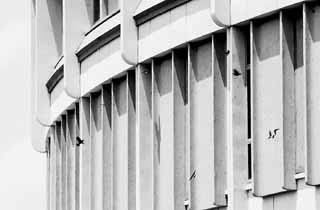Not for the Birds
Barn swallows like the Airport Hilton, but the Airport Hilton does not like barn swallows.
By Michael King, Fri., May 17, 2002

Barn swallows are not welcome at the Airport Hilton. That was the definite message the birds got last week, as hotel maintenance workers worked their way around the building in an attempt to clean out, destroy, and further discourage any nests by installing netting in their way.
Swallows prefer to create their mud nests within and below horizontal nooks and crannies in high places -- and the circular hotel has plenty of both. A colony of several hundred birds spends summers in Austin from roughly April to August, many of them in the airport area, before traveling to their winter range in South America. According to state and federal wildlife authorities, barn swallows are a state and federally protected species of migratory birds. Under most circumstances, said David Sinclair, chief of wildlife enforcement for Texas Parks and Wildlife, no one is allowed to "possess or kill" the birds, or "destroy or disturb" their nests during the nesting season -- that is, now -- although enforcement of the law is a federal responsibility.
Asked about the hotel's actions, Hilton personnel insisted that all the workers were doing is "putting up some netting so the birds won't nest there," and referred all further questions to the city of Austin's Aviation Dept., which oversees the entire airport property (including the hotel site). Department spokeswoman Jackie Mayo confirmed that the birds had begun nesting on the hotel last year, and when they returned this year, she said, some rooms had to be closed because of "health concerns" -- for example, that the birds might carry "parasites." Mayo said workers were hosing out the nests under windows and installing "chicken wire" in an attempt to "move the birds elsewhere."
Indeed, on Monday of this week, the workers had completed much of that job, and the convex metal netting appeared to be working -- swallows were approaching but not landing at those cornices, although on the eastern face of the hotel, a few dozen nests appeared completed or nearly so, with swallows steadily working in the area.
Mayo cited the airport's "federal depredation permit" as allowing the removal of the birds. But the permit authorizes the city only "to take [birds] ... that are found in the immediate vicinity of the runways and pose an immediate and probable threat to approaching and departing aircraft." Officials at the U.S. Fish and Wildlife Service office in Albuquerque, which issues the depredation permits, at first said the hotel's nest clearing would not be allowed by the permit -- but a few hours later said an Austin-based federal warden had investigated and "no violations were found at this time." Public information officer Tom Bauer said the agency is "still looking into" the airport's actions, to make certain that what was going on was only "habitat modification" to discourage the birds (as specified by the permit), and not "lethal control."
Carl Wilson, the Austin Fish and Wildlife enforcement agent who investigated the project last week in response to several phone complaints, said that he could find no evidence of injured or dying birds, or broken eggs, although he searched the whole area and nearby dumpsters. "The birds apparently hadn't begun laying yet," Wilson said, and the workers were scraping out the nests, not attacking the birds. He said installing the screening is a reasonable measure, but he questioned the hotel's timing, "why they waited until the nests were already there." And he said he was continuing to look into the issue of whether the depredation permit could cover the hotel property or whether the agency would need to conduct a criminal investigation. As written, he added, "the permit wouldn't allow depredation" for health concerns, or anything but "immediate and probable" danger to aircraft.
Mayo said that the aviation department takes the position that anything on the 4,200-acre airport property is in the "immediate vicinity" of aircraft, and that the hotel is only 1,000 yards from the runways -- "and birds fly." Yet an even larger colony of swallows and their nests under the bridge just east of the hotel has thus far been undisturbed while they steadily build their adobe nests.
Asked why the hotel couldn't have installed the chicken wire or other habitat modification during the winter months, Mayo said the department had been "working with the Hilton" but apparently such methods hadn't yet succeeded. "It is not our intention to hurt [the swallows] or harm them or kill them," Mayo said. "We're just trying to get them to find another place to nest."
The birds may have other ideas. According to the Cornell University laboratory of ornithology, "Returning Barn Swallows show strong fidelity to their natal site, most nesting within 20 miles of their birthplace and some much closer. Members of a pair typically stay together to raise a second brood and return in successive years to the same nest site."
Got something to say on the subject? Send a letter to the editor.








